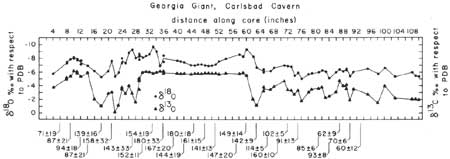
|
New Mexico Bureau of Mines & Mineral Resources Bulletin 117
Geology of Carlsbad Cavern and other caves in the Guadalupe Mountains, New Mexico and Texas |
| PART I: SPELEOGENESIS |
ANALYTICAL METHODS AND RESULTS
Sulfur-isotope method
Fractionation processes
Sulfur has four stable isotopes with mass numbers 32, 33, 34, and 36. The relative proportions of 32S and 34S in sulfur compounds from various geologic environments vary markedly (Fig. 72), the isotopes being fractionated by long-term geochemical cycling and particularly by metabolic processes of the sulfur bacteria, Bacteria break S—O bonds and so create large isotopic changes, whereas chemical oxidation-reduction reactions affect O—O bonds and so create small isotopic changes. Thus, the sulfur-isotope method is a way of distinguishing sulfur formed by geological processes from that formed by biological processes. When sulfur bacteria interfere in oxidation-reduction reactions, 32S is significantly enriched relative to 34S; such an interference produces isotopic fractionations on the order of 10-20%. On the other hand, geologic leaching of sulfide minerals such as pyrite produces fractionations of less than 1% (Goodwin et al., 1976).
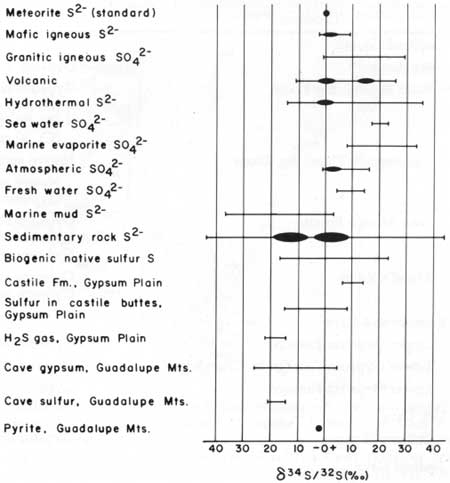
|
| FIGURE 72—σ34S values for various geologic environments. Gypsum and sulfur in Guadalupe caves are significantly enriched in 32S compared to the gypsum and anhydrite of the Castile Formation in the Gypsum Plain. After Holser and Kaplan (1966). |
Sulfur isotopes are usually expressed in terms of σ34S values which relate the isotopic ratio 34S/32S of a sample to that of a standard:

The overall isotopic fractionation effect approaches the sum of several separate steps for the reduction and oxidation of sulfur:

In all four steps the products are enriched in 32S relative to the reactants. In step C, the reaction may proceed with the help of bacteria or, alternatively, may occur spontaneously when the sulfide oxidizes in the presence of oxygen. Variations in kinetics can cause marked changes in the overall isotopic effect of these reactions, Near the range of cave temperatures (12-15°C), the reduction reactions A and B are approximately twice slower than at 25°C (Kaplan and Rittenberg, 1964). As opposed to temperature, isotopic fractionation is relatively independent of pH, because most organisms have internal pH control (Kemp and Thode, 1968).
The sulfur bacteria responsible for the oxidation and reduction of sulfur compounds are Desulfovibrio desulfuricans, which reduces sulfate to hydrogen sulfide in the presence of petroleum, and Thiobacillus thiooxidans, which can oxidize hydrogen sulfide and sulfur to sulfuric acid and sulfate even in a pH regime of 0 (i.e. an environment that is 1N with respect to sulfuric acid; Stanier et al., 1957; Davis and Kirk land, 1970).
Sulfur-isotope values of cave gypsum and sulfur
The gypsum and sulfur deposits in Guadalupe caves are significantly enriched in the light isotope of sulfur (32S). Hill (1980b, 1981d) reported σ34S values as low as -21.1 for cave gypsum, and σ34S values as low as -20.0 for cave sulfur. Kirkland (1982) obtained similar isotopic values for the gypsum blocks of the Big Room, Carlsbad Cavern (σ34S = -15.0 to -22.0). This paper expands on the earlier work of Hill, and includes sulfur-isotope data on sulfate speleothems and pyrite as well as on gypsum blocks and native sulfur (Table 22).
TABLE 22—Sulfur-isotope analysis (by Geochron Labs).
| Location | Sample | σ34S |
| Carlsbad Cavern | ||
| Big Room | Gypsum block | -13.9 |
| Polar Region, Big Room | Gypsum block, vertical suite | |
| (A) Top sample in suite | -17.6 | |
| (B) 30 cm below (A) | -19.9 | |
| (C) 30 cm below (B) | -21.1 | |
| Jumping Off Place, Big Room | Native sulfur mixed with gypsum in a gypsum block | |
| Native sulfur | -20.0 | |
| Gypsum | -19.0 | |
| New Mexico Room | Gypsum block | -25.6 |
| Gypsum flower | +9.2 | |
| Gypsum crust | +8.7 | |
| Mabel's Room | Gypsum block | -17.8 |
| Gypsum stalagmite | +7.3 | |
| Cottonwood Cave | ||
| Upper Gypsum Passage | Gypsum block | +5.0 |
| Lower Gypsum Passage by Chandelier | Native sulfur | -14.6 |
| Lower Gypsum Passage | Gypsum crust | -0.8 |
| Dry Cave | ||
| Balcony Room | Gypsum block | -12.4 |
| Endless Cave | ||
| Lower Maze | Gypsum block | -8.6 |
| Guadalupe Ridge | ||
| On surface near Cottonwood Cave | Pyrite in an exposed limonite piece in Yates Fm.; 1% pyrite | -2.5 |
It is interesting to compare σ34S values obtained for the cave deposits with those reported by Kirkland and Evans (1976) for oil and gas-generated sulfur in the castile buttes of the Gypsum Plain (Fig. 72). The castile sulfur has σ34S values of +9.2 to -15.1, whereas the cave gypsum and sulfur have σ34S values of +5.0 to -25.6. Both types of deposits fluctuate widely in their degree of fractionation; such large fluctuations over short distances are diagnostic of biologic systems because bacterial populations are always changing depending on nutrient levels and temperature (Goodwin et al., 1976). The sulfur-isotope values of the cave gypsum and sulfur also compare closely with values obtained for hydrogen-sulfide gas liberated from oil and gas reactions in the Delaware Basin (Fig. 72). According to the U.S. Department of Energy (1983), σ34S values of H2S associated with brines at the WIPP and ERDA sites averaged -14.4 and -20.5, respectively.
It is also interesting to compare actual σ34S and fractionation values of the cave gypsum and sulfur with theoretical values expected for reactions A through D in reaction (2), as have been reported by other investigators. If the SO42- of reaction A represents the sulfate of the Gypsum Plain anhydrite (with an average σ34S value of +10.3) and the SO42 of reaction D represents the cave gypsum sulfate, then the average amount of fractionation that has actually occurred in the cave gypsum (-15.1) compares closely with that theoretically expected (-15.6) for biological fractionations in reactions A through D at cave temperatures (Table 23).
TABLE 23—Sulfur-isotope fractionation in oxidation-reduction
reactions.
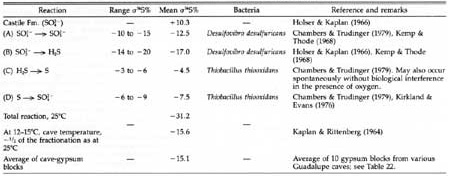
(click on imagte for a PDF version)
Sulfur-isotope values of pyrite
Most of the pyrite in the Yates Formation of the Guadalupe Mountains has weathered to limonite and, therefore, is not suitable for sulfur-isotope analysis. Analyses were attempted on four "pyrite" specimens: one collected from the Hidden Cave Ridge, another from the Guadalupe Room, Carlsbad Cavern, and two from Guadalupe Ridge, 2.5 km east-northeast of the Dark Lookout near McCollum's Pit (collected by D. Jagnow). Only one specimen (one of the Guadalupe Ridge pieces) had enough pyrite (about 1%) for a sulfur-isotope determination (σ34S = -2.5; Table 22). The same piece of pyrite exhibited concretionary structure in thin section.
Other pyrite in the Delaware Basin has been analyzed for its sulfur isotopic content. Mazzullo (1986) reported a σ34S value of +1.2 for pyrite associated with Mississippi Valley-type lead-zinc mineralization in the southeastern, Ft. Stockton part, of the Delaware Basin.
Carbon- and oxygen-isotope methods
Fractionation processes
Fractionation involving carbon and oxygen is similar to that involving sulfur: geological and biological processes produce isotopic-exchange reactions which enrich a substance in one isotope relative to another. In the case of oxygen, two isotopes, 16O and 18O, are involved in the exchange, and in the case of carbon three isotopes, 12C, 13C, and 14C, are involved. Plants generally become enriched in 12C and depleted in 13C and 14C, whereas calcium carbonate precipitated in isotopic and chemical equilibrium with CO2 gas is enriched in 13C. In the case of speleothems, the heavier isotopes of carbon and oxygen are enriched relative to rainwater which falls above the cave, the degree of enrichment depending solely on the temperature of the depositing solutions provided the system is in isotopic equilibrium. This temperature factor makes the carbon- and oxygen-isotope methods useful in determining paleotemperatures under which speleothems formed, and, when used in combination with absolute-age dating methods, this technique can be an important indicator of past climate.
Stable carbon and oxygen isotopes can also be used in paleoenvironmental studies to determine whether certain material (e.g. spar) deposited under marine or fresh-water conditions, Fresh-water carbonates have characteristic isotope signatures: the oxygen composition of meteoric calcites is invariant with depth, reflecting a narrow range of temperature and oxygen composition in rainwater, and the carbon composition exhibits a marked depletion of 13C (relative to marine carbon signatures) at exposure surfaces and a marked enrichment in 13C with depth (Given and Lohmann, 1986). Such trends represent an initial input of 13C-poor bicarbonate from soil organic processes and progressive addition of 13C-rich bicarbonate from the interaction with carbonate host rock.
Furthermore, carbon-oxygen-isotope data are valuable in understanding speleothem-forming processes. An oxygen-isotope shift (towards an enrichment of 18O) incurs with an increase of temperature and solute concentration, and a carbon-isotope shift (toward an enrichment of 13C) takes place with increasing CO2 loss. Thus, as incoming ground water solutions loose carbon dioxide and as evaporation of the solvent takes place, there is a progressive shift from lower σ18O and σ13C values to higher σ18O and σ13C values.
Carbon-oxygen-isotope values of spar
The carbon-oxygen-isotope method has been instrumental in deciphering three separate spar episodes in the Guadalupe Mountains. Spar I and Spar II events have been defined by Given and Lohmann (1986) for samples collected along a "paleoslope" in reef-forereef limestones, McKittrick Canyon (Fig. 73), and Spar II and Spar III events have been defined for spar samples collected in Carlsbad Cavern during this study and during the studies of M. Queen, A. Palmer, and M. Palmer.
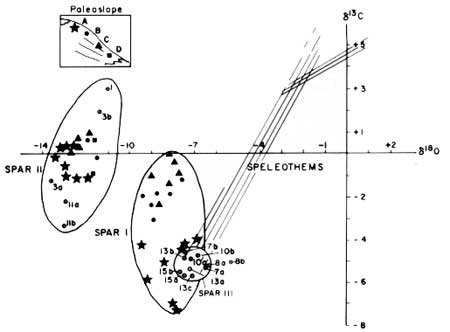
|
| FIGURE 73—Carbon-oxygen composition of spar and speleothems, Guadalupe Mountains and Carlsbad Cavern. The stars, triangles, dots; and squares of Spar I and Spar II represent collection sites on a reef-forereef paleoslope, McKittrick Canyon (Given and Lohmann, 1986). The dotted circles of Spar II and Spar III represent spar and cave rafts collected in Carlsbad Cavern; the a, b, and c's represent the outside to the inside parts of these samples, respectively. The speleothem section is enlarged and elaborated on in Fig. 98. |
Spar I—Spar I is found in small primary pores and solution cavities occurring in marine-cement intergrowths in the Capitan Limestone. Both the spar and cement are characterized by relatively constant oxygen (σ18O = -8) and varying carbon (σ13C = 0 to -7) (Fig. 73), a fact that caused Given and Lohmann (1986) to conclude that both the marine cements and the Spar I crystals represent successive episodes during a single diagenetic event. On the basis of the invariant oxygen composition of Spar I and its restriction to the upper part of the paleoslope (from A to C, but not D; Fig. 73), Given and Lohmann (1986) also concluded that the Spar I diagenetic event represents the establishment of a fresh-water meteoric phreatic system in the reef facies characterized by well-defined downdip gradients in rock-water interaction to level C in the paleoslope, and that this meteoric system was active contemporaneously with the growth of the reef complex (i.e. in Guadalupian time of the Permian; see Table 1). The trend of marked depletion in σ13C at the top of the paleoslope (stars, Fig. 73) and enrichment in σ13C with depth (triangles, Fig. 73) represents an initial input of 13C-poor bicarbonate from soil organic processes and progressive addition of 13C-rich bicarbonate from interaction with the carbonate host rock.
Spar II—Spar II is found throughout both the reef and forereef facies, where it occurs in fracture systems and at the center of large pores overlying and postdating Spar I material. Depleted oxygen signatures (σ18O = -11 to -13) characterize Spar II material (Fig. 73), and this, combined with maximum precipitational temperatures implicit in the absense of an exsolved gas phase in primary fluid inclusions, indicates that the Spar II diagenetic event probably did not involve marine-derived fluids and may have been related to an Ochoan (or younger) regional meteoric or shallow-burial phreatic system (Given and Lohmann, 1986). The depleted oxygen composition may possibly be explained by either high temperatures due to burial, or a variation of local meteoric water in σ18O due to climatic conditions at the time of deposition.
Three samples of spar collected from Carlsbad Cavern have carbon-oxygen-isotope signatures compatible with a Spar II genesis (samples 1, 3, 11, Fig. 73). A. and M. Palmer (written comm. 1985) considered sample 3 to be spar filling pre-cave Permian breccia, Secondary Stream Passage, and sample 11 to be spar from the core of a botryoidal crystalline mass in the Lake of the Clouds area. Sample I is a piece of etched dogtooth spar from Left Hand Tunnel.
Spar III—Spar III are large dogtooth crystals which occur in solution cavities or as spar linings (samples 7, 10, 15, Fig. 73). These are not always discernible from Spar II crystals by visible inspection (i.e. Spar II, sample 1), but isotopically they are characterized by relatively constant oxygen (σ18O = -7) and carbon (σ13C = -5 to -6). Spar III crystals are those which have uranium-series ages of >350,000 ybp and an Electron Spin Resonance age of 879,000± 124,000 ybp at the Big Room level (Table 24); i.e., they are most likely Pleistocene in age. The marked depletion of carbon in Spar III crystals is in the same range as that of Spar I (stars, Fig. 73): that is, Spar III originated from a 13C-poor organic soil and did not experience much interaction with the carbonate host rock. This signifies that Spar III crystals probably formed near the top of the water table rather than at depth.
TABLE 24—Age of speleothems and other deposits in Guadalupe Caves.
Abbreviations: FSU, Florida State University, Department of
Geology, Tallahasse, Florida; UT, University of Texas, Department of
Geology, Arlington, Texas; MU, McMaster University, Geography
Department, Hamilton, Ontario, Canada; UK, Geologisches Institut der
Universitat Koln, West Germany; NLB, Niedersachsisches
Landesamt fur Bodenforschung, Hannover, West Germany.
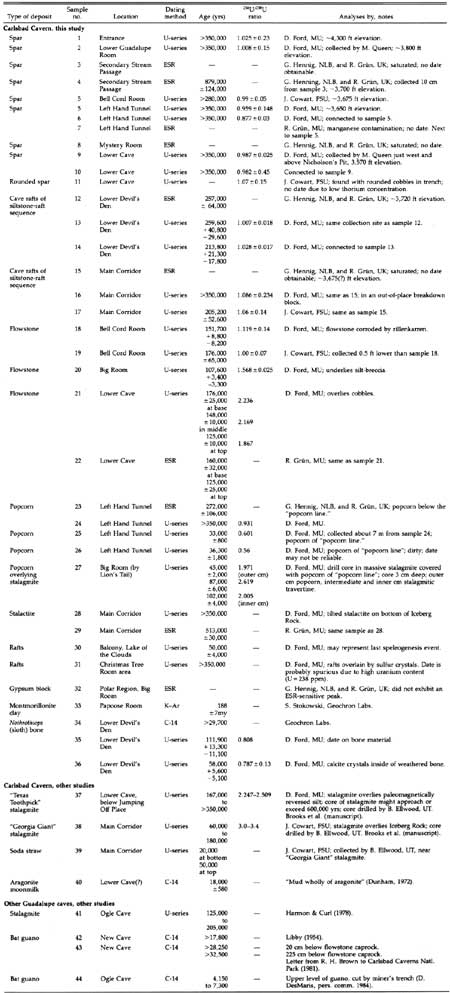
(click on imagte for a PDF version)
Carbon-oxygen-isotope values of cave rafts
The cave rafts of the siltstone-raft sequence (Type 1 rafts) have the same carbon-oxygen signature as Spar III crystals (Fig. 73, samples 8, 13). This suggests that both kinds of deposits formed in the same depositional environment, near (the spar) or at (the rafts) the surface of the water table. Type II rafts (the rafts of the cones, Balcony, the Lake of the Clouds Passage) differ from Type I rafts in their carbon composition (Fig. 98) but have similar oxygen compositions, suggesting that these two deposits formed at similar temperatures or from similar meteoric waters, but that the cave may have been experiencing more air flow, evaporation, or carbon-dioxide loss at the time of Type II raft deposition.
Carbon-oxygen-isotope values of speleothem cores
Brook et al, (manuscript) measured the σ180 and σ13C composition of stalagmitic cores taken from Lower Cave and the Main Corridor, Carlsbad Cavern. Their results on the Texas Toothpick and Georgia Giant stalagmites of these two areas, respectively, show that σ18O and σ13C values were generally much lower during the period from 180,000 to 140,000 ybp, and much higher for the period 140,000 to 60,000 ybp (Figs. 74, 75). They explained the shifts in 13C as due to a change from a more humid, temperate glacial stage dominated by forest types at about 150,000 ybp, to a more semiarid interglacial or interstadial stage dominated by such plants as grasses and sedges at about 125,000 ybp, and the shift in σ18O as due to different precipitation and atmospheric-circulation patterns during these glacial and interglacial periods.
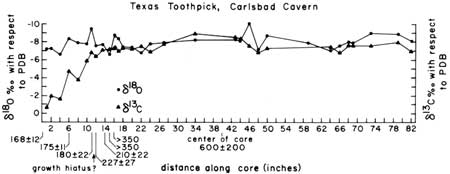
|
| FIGURE 75—Carbon and oxygen stable-isotope data for the Texas are given in 103 yrs. From Brook et al. (manuscript). (click on image for a PDF version) |
Carbon-oxygen-isotope values of bedrock
Three bedrock samples were collected in the Lake of the Clouds-Left Hand Tunnel area, Carlsbad Cavern, for carbon-oxygen-isotope analyses. The purpose of these analyses was to try to determine if the cave was dissolved by hydrothermal water. A hydrothermal event in the Guadalupe Mountains may account for anomalous concentrations of metals in the mountains (Light et al., 1985), and in Carlsbad Cavern it might account for the high temperatures in the Lake of the Clouds Passage (Fig. 19) that may not be completely accounted for by the geothermal-gradient factor. A warm-water, lifting model of speleogenesis might also be supported by these data.
The carbon-oxygen data (Fig. 76) do not conclusively prove that cavern dissolution occurred hydrothermally, but do not rule out that possibility either. Note how the carbon-oxygen values of uncorroded limestone [i.e. the insides of samples (1) and (2) and the entire sample (3)] cluster around σ13C = +4 and σ18O = -3 to -5, values that are typical of marine limestones. Also note how the carbon-oxygen values become increasingly negative for the outside, corroded surfaces of samples (1) and (2) and how these trends seem to be heading toward the hydrothermal carbon-oxygen regime of calcite.
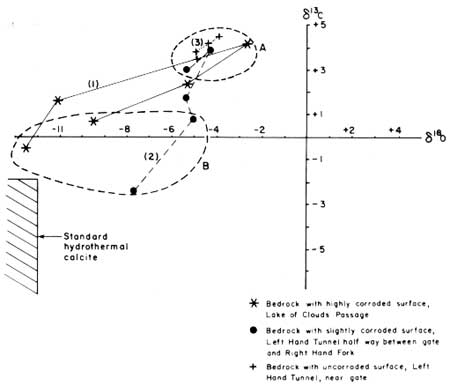
|
| FIGURE 76—Carbon-oxygen isotope data of bedrock, Carlsbad Cavern. Carbon-oxygen isotope values of uncorroded bedrock are typical of marine limestones (A); corroded bedrock is atypical (B). |
However, there may be another explanation for these trends. Bedrock sample (2) and especially bedrock sample (1) were collected in areas of pronounced condensation-corrosion, a process caused by high CO2 levels in the cave air. If this CO2 had derived from the bacterial or inorganic oxidation of methane and thus was characterized by very negative values of σ13C and σ18O (i.e. if some of the carbon dioxide came from the basin as is being proposed in this study), then its reaction with the bedrock might have also produced the trends seen in Fig. 76. The fact that Spar III crystals have a carbon-oxygen signature of σ13C = -5 to -6 and σ18O = -7 to -8 (Fig. 73), far outside the hydrothermal regime, also supports the contention that condensation-corrosion, rather than temperature, was responsible for the depletion of 13C and 18O in corroded bedrock surfaces. In addition, the work of Light et al. (1985) discourages the idea of a thermal episode in the Guadalupe Mountains. These authors found no evidence of hydrothermal alteration of rock samples collected at approximately 1.6 km (1 mile) intervals along Guadalupe Ridge in the Guadalupe escarpment wilderness study area, even though they often found these rocks associated with heavy-mineral, metal concentrates.
Fluid-inclusion method
In order to further test a hydrothermal model of speleogenesis, a sample of dogtooth spar (believed to be Spar III material) was collected from Left Hand Tunnel and subjected to fluid-inclusion analyses. Single-phase, pure-water inclusions are often trapped in speleothems during the precipitation of calcite and, by ascertaining the isotopic composition of these inclusions, important information on paleotemperatures can be obtained (Schwarcz et al., 1976).
Fluid inclusions in the spar were analyzed for σ18O, σ13C, and σD (deuterium/hydrogen). The crystal was an unzoned, dogtooth, Iceland spar, amber-colored and very clear, but highly corroded on its surface. It was acid-cleaned and then physically scraped until clear, uncorroded, crystalline material was reached. The crystal was cleaved (along the c-axis or near to it) to get equal halves for Run A and Run B. The crystalline material was then analyzed for σ18O and σ13C (from split A only).
The spar sample turned out to be a Spar II crystal (σ18O = -11, σ13C = +3, Fig. 73, sample 1). σ18O values of the fluid inclusions were -46.5 and -41.9, and σ13C values were -19.6 and -19.9 (Runs A and B, respectively, PDB standard). σD of the fluid inclusions was -86 and -68 (Runs A and B, respectively, SMOW standard).
Since the spar crystal was not Spar III (Pleistocene) material, no information could be derived for or against a warm-water, lifting model of speleogenesis. However, the Spar II crystal did provide information on Late Permian events. The temperature at which the spar crystallized was calculated from the equation:
1000 in Kcw = 2.78 (106T-2) - 2.89 (3)
where T is the absolute temperature and Kcw is the temperature-dependent equilibrium constant for the isotopic exchange between calcite and water (Schwarcz et al., 1976). The temperature thus calculated was 55.4°C, a value which corresponds to Kevin and Given's (1986) contention that Spar II precipitated from meteoric water at some temperature between 30 and 65°C. This temperature suggests a depth of burial of less than 1 km.
Dating methods
A number of absolute dating methods have been used in this study: carbon-14, uranium series, electron-spin resonance, potassium-argon, and paleomagnetic. Samples were collected primarily in Carlsbad Cavern and were chosen on the basis of their relevance to speleogenesis problems.
Carbon-14 dating of bone and bat guano
The basic principle behind the carbon-14 dating method is that radioactive 14C decays with a half life of about 5,000 years so that, over time, different ratios of 14C and its daughter product 14N exist. One bone sample—that of Nothrotheriops, an extinct ground sloth discovered in Lower Devil's Den, Carlsbad Cavern—was carbon-14 dated at >29,700 years by Geochron Laboratories for the amount of bone sample received (Table 21). Bat guano from New Cave and Ogle Cave has been carbon-dated by other investigators, and dates up to >32,500 have been obtained (Table 24).
Uranium-series dating of speleothems and bone
The isotopes of uranium, 234U and 238U, and the isotopes of thorium, 232Th and 230Th, are present in limestone and limestone-derived soils in small amounts. 234U is selectively mobilized in solution and trapped within the calcite lattice at the time of speleothem deposition; thus, by measuring the ratio of 238U to 234U in present-day speleothem-depositing waters and in the speleothem itself (and knowing the half life of the reaction) the time of deposition of the calcite can be determined. Similarly, 234U decays directly to 230Th with a shorter half life, and hence the events of the late Pleistocene can be measured with accuracy. A disadvantage of the uranium-thorium method is that 230Th has a much shorter half life than 234U, so that an isotopic equilibrium is eventually set up in which the decay of parent and daughter proceeds at the same rate. This constraint usually limits the uranium-series (U-series) method to speleothem samples younger than about 350,000 ybp. However, examination of 234U/238U ratios may sometimes yield dates as high as 1.25 my, if the ratios indicate that isotopic equilibrium has been established over time (Gascoyne et al., 1983). Also, speleothem growth rates may be very cautiously used to estimate the age of travertine if that travertine is over 350,000 yrs old.
The spar crystals are the oldest speleothems in Carlsbad Cavern, and samples from the cave entrance down to Lower Cave (a vertical extent of almost 240 m) have U-series dates consistently >350,000 ybp. An extrapolation beyond 350,000 yrs based on 234U/238U ratios cannot be applied to these dates since it is evident from Table 24 that these ratios have not been constant over time or place but have varied from 0.56-3.4 for all the various types of speleothems dated. Also, the 234U/238U ratio has been shown to vary from 1.78-3.13 for recently collected water samples from Carlsbad Cavern (J. Cowart, written comm. 1985).
Cave rafts of the calcified siltstone-cave raft sequence (Type I rafts) appear to be the next oldest deposit, varying from about 200,000 to >350,000 yrs (samples 12-17; Table 24). These may all be minimum dates due to the fact that at least 80% of the mass of the cave rafts is post-depositional cement material which was introduced sometime after the rafts themselves had formed.
Dates on the Texas Toothpick stalagmite (Fig. 75) are important to a proper understanding of early speleogenesis events in Carlsbad Cavern, and age dates on the Georgia Giant stalagmite (Fig. 74) are important to the understanding of later speleogenesis events. The Texas Toothpick stalagmite in Lower Cave overlies paleomagnetically reversed (>730,000 yrs old) silt (Table 25) and ages of the travertine in the stalagmite itself exceed the 350,000 limit of the U-series dating technique. Based on its fairly constant 234U/238U ratio (between 2.247-2.509) and travertine growth rates (approximately 1 cm/1,000 yrs), a very rough date of 600,000 ± 20,000 yrs can be obtained for the center of the stalagmite core (D. Ford, pers. comm. 1985). When the radiometric ages for the Georgia Giant stalagmite are plotted on a frequency histogram (Fig. 77), they show periods of maximum and minimum growth, and also periods of no growth.
Dates on the popcorn associated with the "popcorn line" range from 33,000 to >350,000 ybp for sites sometimes only meters apart (samples 23-27, Table 24). The relatively low (45,000 yrs) age of the popcorn overlying stalagmitic travertine near the Lion's Tail, Big Room, is consistent with the older ages of the travertine layers directly below it (87,000 ybp for the first centimeter and 102,000 ybp for the next centimeter, sample 27). These dates indicate a steady growth of material from 102,000 to 45,000 ybp and then cessation of growth.
The flowstone (sample 21) overlying the cobbles in Lower Cave, Carlsbad Cavern, shows a steady growth from about 170,000 to 125,000 yrs ago. The date of approximately 150,000-160,000 yrs for the corroded flowstone of the Bell Cord Room, Carlsbad Cavern (samples 18, 19), indicates that pronounced corrosion occurred in this area of the cave some time after 150,000 ybp.
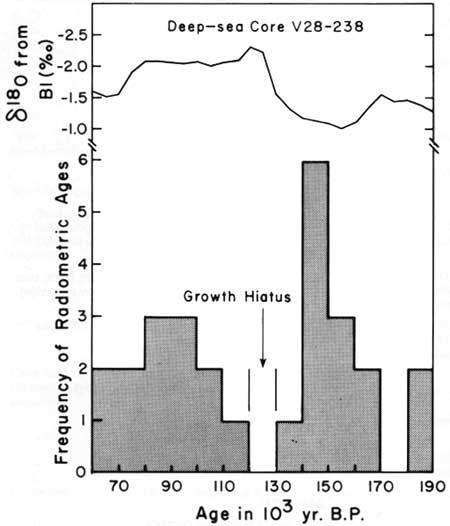
|
| FIGURE 77—Frequency histogram of radiometric ages for the Georgia Giant stalagmite, Carlsbad Cavern, compared to σ18O variations in a deep-sea core 190,000 to 60,000 yrs old. From Brook et al. (manuscript). |
Rafts in the side passage off the Christmas Tree Room were dated in hopes of determining the age of the sulfur crystals overlying the rafts (Table 24, sample 31). Unfortunately, the rafts contained so much uranium (U = 238 ppm) that a reliable date could not be obtained. Rafts making up the outer surface of cones on the Balcony, Lake of the Clouds (Table 24, sample 31) were also U-series dated. The resultant age of 50,000 yrs possibly represents the last fluctuation of base level in the Lake of the Clouds Passage and the last speleogenesis event in the cave.
The U-series date of 111,900 ybp on Nothrotheriops bone material (Table 24, sample 35) signifies the time when the sloth died in the cave and was first subjected to the influence of uranium-bearing ground water, and assumes that the uptake of uranium by the bone was relatively rapid and reached some saturation level after a time which is short compared with the age of the bone. The 111,900 ybp date is consistent with the 58,000 ybp date on calcite crystals that grew in marrow already badly weathered (Table 24, sample 36). This U-series date of approximately 112,000 ybp is the oldest absolute date ever obtained for Nothrotheriops (Hill and Gillette, 1987).
Electron Spin Resonance dating of speleothems and gypsum
The Electron Spin Resonance (ESR) method is a new dating technique developed over the past few years (Ikeya, 1975, 1978; Hennig and Grun, 1983). The main advantage of the ESR dating method is that it can be used on speleothems which are one million years old or older, and the method thus covers much of the speleogenesis time in Guadalupe caves. Also, this method can sometimes be used on gypsum as well as calcite,
The ESR dating technique is similar to U-series dating, but measures radiation-induced defects in the calcite crystal lattice rather than the amount of daughter isotopes. Radio active decay produces trapped electrons (CO33-) or trapped holes (CO3-), and the traps are detected by directly measuring microwave adsorption in a strong magnetic field. The number of traps is proportional to the amount of decay and the time involved; hence the age and growth rate of the speleothem can be determined.
ESR age dates are calculated from the archaeological (AD or total) radiation dose and the annual radiation dose. The archaeological-dose rate is evaluated by means of ESR spectrometry and by considering the uranium content of the sample; the annual radiation dose is obtained by measuring gamma-ray exposures at collection sites within the cave. Gamma-radiation exposures, as measured in Carlsbad Cavern, are listed in Table 6; measurements made by Moore (1984) were performed using a Ludlum Micro R Meter.
The results of the ESR dating are listed in Table 24. Of the four spar samples submitted for ESR dating, only sample 4 gave a date; the other three samples (3, 7, 8) were "saturated." The condition of saturation means that all the available traps are occupied, and may indicate either that a sample is very old or that it is contaminated by such impurities as manganese (defect ions which act as traps). In younger (<350,000 yrs), non-spar speleothem samples (12, 22, 23, 29), ESR dates compare nicely with U-series dates for the same samples, a fact that lends credibility to the 879,000 ± 124,000 ESR date on spar sample 4.
The sample of gypsum block, collected from the Big Room, Carlsbad Cavern, did not exhibit an ESR-sensitive peak and so provided no age information.
Potassium-argon dating of montmorillonite clay
Based on stratigraphic relationships, the montmorillonite clay filling solution pockets is believed to be older than at least some of the spar. For this reason, the clay was dated by the potassium-argon method, which is suitable for materials one million years old or older. The potassium-argon method uses the decay of 40K to 40Ar, a gas which can be measured with great accuracy. The method has its difficulties, the most notable being the loss/gain of potassium or the loss of argon from a system, especially in the case of sedimentary deposits which are subject to ground-water leaching. Inheritance of old argon and potassium from the time the limestone was originally deposited can also be a serious problem, one resulting in anomalously old dates. Another problem is that the potassium content of autochthonous cave clay is usually very low and not suitable for dating by this method. Furthermore, dates have never before been achieved on montmorillonite samples (T. Bills, Geochron Labs, pers. comm. 1985); illite is the only clay mineral which has been successfully dated by the K-Ar method.
Montmorillonite clay collected from the Papoose Room, Carlsbad Cavern, has been found high enough in potassium (1.84%) to qualify for potassium-argon dating. The date obtained on the clay was 188 ± 7 my (Early Jurassic). This date is problematical because it is not known how the above factors relate to it. Vadose ground-water contamination has probably been relatively minor, at least in the recent past, since vadose drip water entering the cave is low in potassium (0.39-6.65 ppm; Table 28), and Capitan aquifer water is also very low in potassium (0.78-2.15 ppm; Table 2). Detrital feldspar in the clay contained only 0.13% K, which rules out any significant contamination from this source.
Paleomagnetic dating of silt and speleothems
The magnetic field of the Earth does not remain constant over time, but fluctuates in direction about geographic north and, once every half a million years or so, reverses polarity. Such changes provide a basis for dating rocks and sediments. In this method magnetic material (usually iron-mineral grains) align in the direction of the Earth's magnetic field at the time of rock crystallization, sediment deposition, or calcium-carbonate deposition in a speleothem.
A paleomagnetic determination of calcium carbonate in the Texas Toothpick stalagmite, Lower Cave, was attempted by D. C. Ford (pers. comm. 1985), but not enough iron was found present in this speleothem in order to make a magnetic determination of the travertine. Brook et al. (manuscript) report that some parts of the core of the Georgia Giant stalagmite record a stable remanent magnetism (Fig. 78); Zijderveld vector diagrams for two samples (CB-64, CB-74) demonstrated straight-line decay to the origin with a. f. demagnetization to 50 mT. However, other samples (CB-62, CB-75) were not stably magnetized, and a continuous record of secular variation in the Earth's magnetic field over time thus cannot be constructed with the data so far obtained.
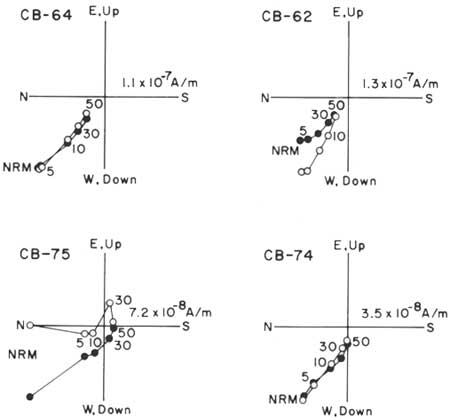
|
| FIGURE 78—Zijderveld vector diagrams showing natural remanent magnetism in the Georgia Giant stalagmite, Iceberg Rock, Main Corridor, Carlsbad Cavern. From Brook et al. (manuscript). |
Paleomagnetic age determinations of silt were made during this study on samples collected from Lower Cave, Carlsbad Cavern. Samples of sediment were collected using a 2 cm plastic box while noting proper compass orientations after the manner of Schmidt (1982). Paleomagnetic analyses were performed on the samples by the University of Pittsburg Rock Magnetism Laboratory using a cryogenic magnetometer. The results of this age determination are listed in Table 25.
TABLE 25—Paleomagnetism of silt, Lower Cave, Carlsbad Cavern.
| Location | Description | Date | |
| Green Clay Room | Laminated silt | >730,000 yrs; magnetically reversed | |
| 60 m past Rookery | Nonlaminated silt | >730,000 yrs; magnetically reversed | |
| Nooges Realm | Nonlaminated silt | >730,000 yrs; magnetically reversed | |
| 15 m before "Stegosaurus" rock | Nonlaminated silt | ||
| 1.2 m above floor | Vertical sequence | >730,000 yrs; magnetically reversed | |
| 4.5 m above floor | Sample not compact enough, no results | ||
| 7.5 m above floor | >730,000 yrs; magnetically reversed | ||
All of the silt samples collected in Lower Cave had reversed polarity, meaning that the sediments were deposited more than 730,000 yrs ago, before the most recent magnetic-field reversal, the Brunhes/Matsuyama reversal. The data are consistent with the assertion that all the sediment was deposited at the same time, but there is no proof that this was the case. If the sediments were of both normal and reversed polarity in the vertical sequence at Stegosaurus Rock, then the absolute age of the deposit could be better established; but with all the samples showing reversed polarity, only a lower limit of 730,000 yrs can be set for the silt deposits of Lower Cave. While it is possible that the Lower Cave silt was paleomagnetically reversed in a pre-Brunhes/Matsuyama reversal, it is not likely because the extrapolated date (600,000 ± 200,000 yrs) on the Texas Toothpick stalagmite, which directly overlies the silt, approaches the lower limit of the Brunhes/Matsuyama reversal (730,000 yrs). Hence the age of the silt in Lower Cave probably has an upper limit of 0.9 my, which defines the lower limit of the next reversal event, the Jaramillo normal episode.
Chemical analyses
Whole-rock analyses
Egemeier (1973, 1981) demonstrated that limestone and overlying gypsum crust on the walls of replacement-solution caves in the Big Horn Basin, Wyoming, are chemically related to each other. Egemeier's chemical correlation was done using paired specimens of gypsum and limestone, with the gypsum crust directly overlying the limestone. The premise of Egemeier's paired-specimen analysis was this: if gypsum formed as a direct replacement of limestone, then it should show chemical similarities to the limestone in the metal ions of calcium, magnesium, sodium, potassium, and iron. Since the sulfate minerals of these metal ions are more soluble than the carbonate minerals, then the gypsum should possess an equal amount or less of these cations than the limestone, depending on the amount of leaching the gypsum has experienced. Egemeier used strontium as a basis for comparison of leaching, because it forms the least-soluble sulfate.
Whole-rock analyses were performed on limestone-gypsum pairs in the hope of defending or rejecting a replacement-solution model of speleogenesis for Guadalupe caves (Table 26). Four separate locations were chosen for sampling on the basis of their being in different limestone facies: (1) the Big Room, Carlsbad Cavern (Capitan Limestone); (2) the Big Room, Carlsbad Cavern (Bell Canyon Formation(?), Bottomless Pit); (3) lower Gypsum Passage, Cottonwood Cave (Seven Rivers Formation); and (4) Sand Cave, McKittrick Hill (Yates Formation). Inasmuch as gypsum in Guadalupe caves usually forms as floor blocks rather than as thin wall crusts (as is the case in the Big Horn Basin caves), gypsum blocks were sampled as close to the limestone bedrock as possible (within one meter).
TABLE 26—Whole-rock analyses (done by J. Husler, Chemistry
Laboratory, Geology Department, University of New Mexico; those denoted
by asterisk are by K. Emmanuel, University of New Mexico, and J.
Bologna, Los Alamos National Laboratory).
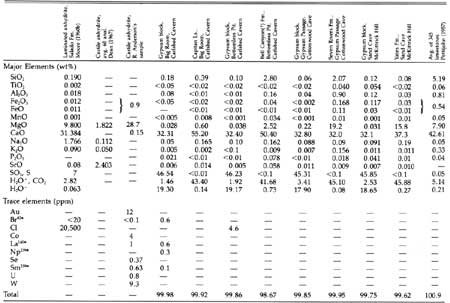
(click on imagte for a PDF version)
My analyses for paired gypsum-limestone specimens do not match Egemeier's results. In Egemeier's study, the different cation ratios of Mg/Sr, K/Sr, Ca/Sr, Fe/Sr, and Na/Sr are always equal or higher for limestone than for gypsum in a pair. No such systematic correlation could be found in the gypsum-limestone pairs of Guadalupe caves; for all the cations except magnesium, the cation to strontium ratio was mixed (Fig. 79). In 11 samples, cation ratios for the limestone were higher than the gypsum ratios; in nine samples they were lower.
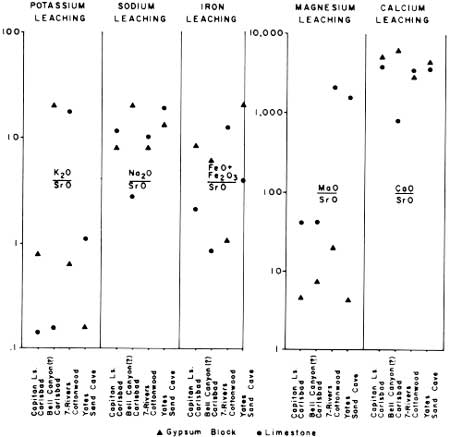
|
| FIGURE 79—Paired specimens of limestone and gypsum collected from the Capitan Limestone and Bell Canyon(?) Formation, Big Room, Carlsbad Cavern; the Seven Rivers Formation, Cottonwood Cave; and the Yates Formation, Sand Cave. |
The whole-rock analyses of Table 26 are also beneficial when comparing the cave gypsum with the gypsum and anhydrite of the Castile and Salado Formations in the Gypsum Plain. The chemical composition of these deposits is very different, especially in strontium, magnesium, sodium, and chloride.
Sulfate content of limestone
A 20 cm deep hole was drilled in the Capitan Limestone (reef facies) near the Salt Flats of the Big Room, Carlsbad Cavern, in order to ascertain whether gypsum had replaced limestone with depth in the wallrock. The core was drilled 1.2 m above the floor and about 1 m away from a gypsum block that abuts against the cave wall. The drilling method was the same as used by Hill (1981c).
The results of the drill-core analyses are shown in Fig. 80. Maximum values of sulfate are about 0.1%; they are highest at the bedrock surface in the first 2.5 cm, decrease for the next 7.5 cm, and then stabilize at about 0.008% sulfate for the remaining 10 cm. This trend compares with that for nitrate in bedrock, Natural Entrance, Carlsbad Cavern (6 ppm for the first 2.5 cm, 1-2 ppm for the next 10 cm, and then stabilizing at about 0.5 ppm; Hill, 1981c). Hand specimens of limestone collected in the Capitan Limestone and Bell Canyon Formation(?), Big Room, Carlsbad Cavern, and those collected in the Seven Rivers Formation, Cottonwood Cave, and in the Yates Formation, Sand Cave, also contain less than 0.1% sulfate (Table 26).
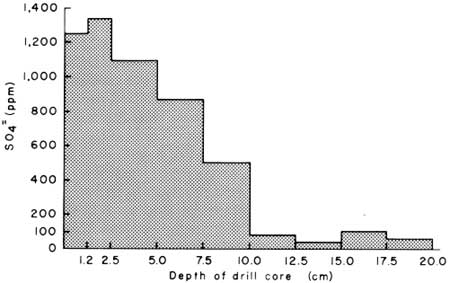
|
| FIGURE 80—Sulfate content in a bedrock core, Big Room, Carlsbad Cavern. |
Insoluble residue in limestone
Limestone samples from Carlsbad Cavern were analyzed for their insoluble-residue content. The limestone was dissolved in 50% hydrochloric acid and the insoluble residue filtered out, weighed, and described. The samples yielded between 0.1 and 99.3% insoluble residue, with the highest residue content in the limestone of the Bell Canyon(?) Formation in the New Mexico Room (Table 27).
TABLE 27—Insoluble residue in bedrock, Carlsbad Cavern.
| Location | Formation | Description of residue | Insoluble residue (%) |
| Bat Cave (near entrance) | Tansill | Not described (Hill, 1972) | 1.6 |
| Auditorium | Yates(?) | Not described (Hill, 1972) | 1.7 |
| Main Corridor | Capitan (reef) | Not described (Hill, 1972) | 0.9 |
| Big Room, Bottomless Pit | Bell Canyon(?) | Cream-colored, fine-grained; black specks (magnetite?) | 11.7 |
| Lower Cave, Green Clay Room | Capitan (reef) | Grayish brown, fine-grained; some quartz grains (-0.05 mm) | 1.3 |
| Lower Cave, Junction Room | Capitan (reef) | Medium-brown, fine-grained silt | 0.1 |
| Lower Cave, near entrance to Rookery | Capitan (reef? or reef talus?) | Light tan residue; solution of acid was quite orange | 4.5 |
| Lower Cave, beneath Talcum Passage | Capitan (reef) | Light tan; solution of acid was quite orange | 1.2 |
| Lower Cave, near the entrance to the Cable Slot | Capitan (reef) | Light tan; solution of acid was quite orange; some gypsum from secondary veins or crust | 2.0 |
| New Mexico Room, near descent to East Annex | Bell Canyon(?) | Clean, white to light tan, fine-grained | 99.3 |
| New Mexico Room, 5 m from descent to East Annex | Bell Canyon(?) or Seven Rivers(?) | Very light orange, fine-grained | 36.1 |
Color, grain size, and the amount of insoluble residue vary within a particular limestone facies, as shown by the samples collected at different locations along Lower Cave. The insoluble residue in the Bell Canyon(?) facies in the New Mexico Room and at Bottomless Pit, Big Room, was quite different from residue in the reef-forereef limestone collected in Lower Cave. The residue in bedrock at these localities exactly matches (in color, grain size, and included black magnetite?) the white to cream-colored, fine-grained silt on the floor (compare the description of the Bottomless Pit and New Mexico Room silt in Table 10 with that of the insoluble residue in bedrock at the same locations in Table 27). Insoluble residue derived from Lower Cave limestone is orange to tan, which agrees with the description of silt on the floor (again, compare Tables 10 and 27).
Sulfuric-acid experiment on limestone
Two small-scale laboratory experiments were performed in order to show the reaction of sulfuric acid on limestone. First, finely powdered calcium carbonate was combined with 0.05 M sulfuric acid and stirred vigorously; after 24 hours, fluffy white gypsum precipitated to the bottom of the beaker, with a thinner layer of gypsum coating the lower sides of the beaker and also the stirring rod. This simple experiment mimicked one feature seen in Guadalupe caves: the gypsum thinning from the bottom upward along the sides of the beaker is visually analogous to gypsum floor blocks grading into gypsum rinds along cave walls (Fig. 48).
Next, a more elaborate experiment was conducted using a small piece of Tansill limestone (Fig. 81). A 0.01 M sulfuric-acid solution was added to a large beaker containing the limestone piece, and the solution was slowly agitated on a magnetic stirring plate. After one week the reaction stopped due to an inert layer which had developed over the limestone surface. Fresh acid was then periodically added to the solution to keep the limestone constantly dissolving. This was continued over a period of a few weeks and then the solution was allowed to come to rest. The insoluble residue released from the acid reaction with limestone immediately settled out of suspension and sank to the bottom of the beaker. A scum on the surface of the solution was collected and found to contain tiny pieces of chert. Precipitation of the gypsum did not occur until several months later when evaporation concentrated the solution and caused the gypsum to precipitate as a white coating over the top parts of the limestone piece and over the top of a small beaker placed inside the large beaker (Fig. 81). The gypsum precipitate was examined and found to contain small (0.2 mm or less) detrital pieces of chert.
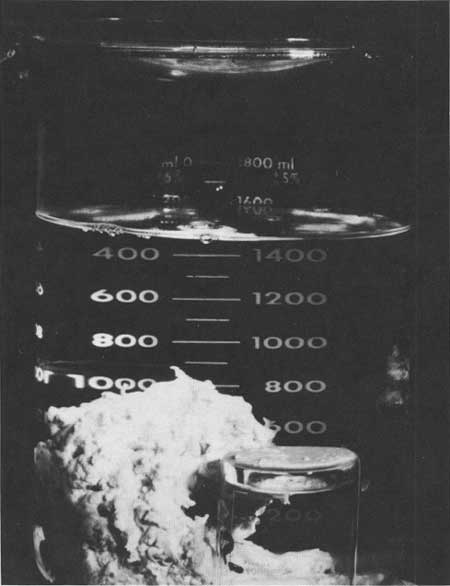
|
| FIGURE 81—Experiment showing a piece of limestone dissolved in sulfuric acid with gypsum formed as a by-product of the reaction. The gypsum precipitated on top of the limestone and also on top of the small glass beaker inside the larger beaker, showing that replacement of limestone by gypsum was not involved in the reaction. |
Many parallels exist between this experiment and what can be seen in Guadalupe caves. The insoluble residue sank first to the bottom of the beaker and then relatively pure gypsum precipitated out on top of the silt and limestone. This is exactly the relationship seen between the gypsum and silt in Guadalupe caves. The silt always underlies the gypsum and the gypsum is relatively pure, containing almost no detritus except for tiny pieces of chert (Table 15).
Water analyses
Analyses of pool and drip water in Carlsbad Cavern have been performed by Boyer (1964), L. Gonzales (unpubl. data 1986), and Hill (this study) (Table 28). A Schoeller-Berkaloff diagram was prepared from these data so that the chemical character of different cave waters could be readily compared (Fig. 82). "Normal" pool and drip water, as described in Fig. 82, are actual samples of water which most closely match the average of 40 samples of pool and drip water analyzed by L. Gonzales.
TABLE 28—Geochemical character of vadose water in Carlsbad
Cavern.
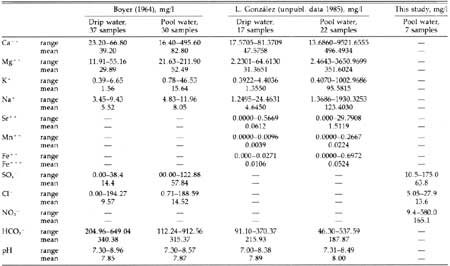
(click on imagte for a PDF version)
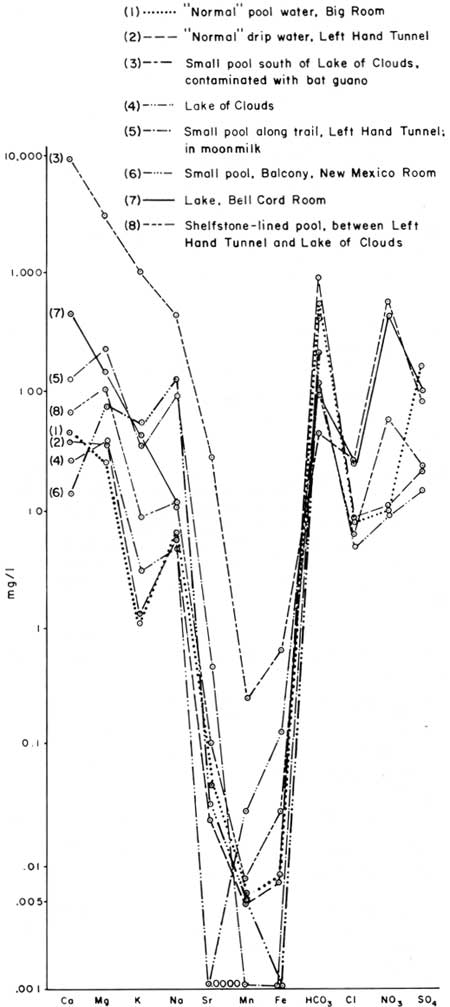
|
| FIGURE 82—Schoeller-Berkaloff diagram of drip and pool water, Carlsbad Cavern. |
The chemical signature of water in Carlsbad Cavern is essentially the same for drip and pool water, with the exception of pool water which has been contaminated by bat guano [curves (3) and (7), Fig. 82]. Bat guano in Carlsbad Cavern is known to contain nitrate and potassium (Table 20), and bat guano from other caves is known to contain sodium, chloride, magnesium, calcium, and sulfate (Hutchinson, 1950). Thus, bat-guano contamination can account for the relatively high concentrations of these ions in some pool-water samples.
A high Mg/Ca ratio in pool water probably indicates that the pool has undergone a significant amount of evaporation. For example, the pool along Left Hand Tunnel [curve (5)] has probably experienced more evaporation than the pool in the Big Room [curve (1)]. Deep pools such as the Lake of the Clouds [curve (4)] have approximately the same chemical signature as shallow pools, e.g. the ones in Left Hand Tunnel [curve (5)], New Mexico Room [curve (6)], or in the shelfstone-lined pool between Left Hand Tunnel and the Lake of the Clouds [curve (8)], signifying that the water for both came from the same source [dripping water, curve (2)]. However, the absolute amount of cations in solution is much higher in the shallow pools than in the deeper pool due to evaporation.
| <<< Previous | <<< Contents >>> | Next >>> |
state/nm/1987-117/sec6-1.htm
Last Updated: 28-Jun-2007
